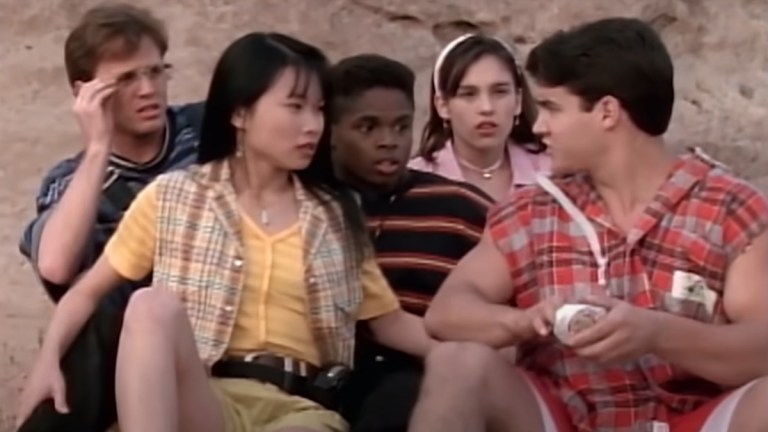Power Rangers: Director of Newly Found First Episode Reveals All
The director of Power Rangers’ very first episode finally rights a 30-year-old wrong with his release of an early version of “Day of the Dumpster.”

Timing is everything. On April 29, 2024, Den of Geek published an article breaking down the mysteries of the supposed “lost” second pilot of Mighty Morphin Power Rangers. We put forth that this long rumored version of the first episode, “Day of the Dumpster,” glimpsed in convention footage, didn’t exist as most fans assumed. That, in fact, the aired version was mostly made of that supposedly “lost footage.” End of the discussion, right?
Just under a week later, Adrian Carr, director of “Day of the Dumpster” and other early episodes of Power Rangers, released his original edit of that installment that revealed some of our analysis was correct but others were blown out of the water by new revelations. For instance, the earthquake scene when the Rangers teleport for the first time? Different in this version, contrary to what we suspected.
(For those wondering, Carr confirmed his upload had nothing to do with our earlier article. “It’s the biggest coincidence known to mankind,” he laughs.)
We sat down with Carr shortly after he released his earlier version of the first episode, which includes several scenes not seen in the aired version, extended fight scenes, and the Rangers battling a whole different monster!
“To this day, I still do not understand why it was reshot,” Carr says when asked why so many changes were made to the first episode. Carr was not involved in the re-shoots and re-edits and for 30 years he’s felt disappointed and unfulfilled over it.
But let’s wind the clock back to 1993. Power Rangers had been picked up to series and Carr was brought in by Saban Entertainment because of his background in martial arts. Executive producers Haim Saban and Shuki Levy showed Carr the pilot episode that had already been shot with the note, “this is what we don’t want to do.” In particular, they didn’t want the violence to be as heavy. The pilot episode had soon-to-be Ranger teens get into an extended fight sequence with a gang of bullies. The Rangers deliver full punches to the chest, flip people over, headbutt and kick to the face, and even kick a bowling ball into someone. This kind of full human-on-human fight contact was rare in the series to come.
When Carr began work on the first episode he kept this in mind with the rule that the Ranger teens could never make contact with a punch or a kick. This is on full display in what we called the “chili fight” scene which didn’t make it into the aired version.
“It’s always the bullies outsmarting themselves,” Carr explains. “(The Rangers) dodge the bullies. The bullies connect with each other. Kimberly swings around on the pole over the bar and does a backflip and doesn’t make contact but the action of it throws the other girl off balance. Everything in that fight sequence at the Juice Bar, you could liken it to vintage physical comedy.”
The purpose of the chili fight scene for Carr was not only a way to introduce the main characters but, for the Rangers to, “develop those moments (in the first episode) so that their skills become more revealed as time went on.” This can be seen as Trini works on a training exercise with Jason (Austin St. John), Kimberly’s gymnastics moves, Jason springing right back up after falling down, Zack’s (Walter Jones) dance-inspired moves, and in particular how Billy (David Yost) acts in the fight.
“Billy’s not a fighter,” explains Carr. “He’s smart. He’s a pacifist. He’s the one who thinks the alternate way of not having to fight their way out of things. He’s more scientifically motivated and oriented. That’s why he ducks under them when the two guys punch each other. These were all the subtle differences in the characters that we were setting up in that one scene.”
Carr believes his version of the scenes in the Juice Bar flow much smoother than the reshoots.
“The flow of it, the information (in the aired version) is jarring. It doesn’t lead you through.”
In the reshoots for the aired version of “Day of the Dumpster” some of Carr’s intentions were carried over but they don’t work anywhere near as successfully. In particular, the aired version cobbles together a new introduction scene that feeds into a karate lesson between Jason and Billy that was pulled and repurposed from an episode shot later in production. This causes a disconnect in the aired version of the plot, where Billy’s attempts to learn karate are set up and never called back to, even after he morphs and is able to perform incredible feats of martial arts.
Carr’s depiction of Billy is much more streamlined, flowing from his awkward attempts to dodge the blows of human bullies in the Juice Bar to doing the same thing in the fight with the evil alien Putty foot soldiers. That entire first unmorphed Putty fight works much better when you watch the “chili fight” because the Rangers’ talents and abilities, which were more than enough to take out the bullies, aren’t as effective against the Putties. The clearest example of this can be seen with Zack’s dance moves at the beginning of the fight mirroring the same ones he used in the “chili fight.” Interestingly in Carr’s version the soundtrack as Zack begins the fight doesn’t cut to a funky little music riff and instead keeps the hard rock going.
The changes to the Putty fight are also a sore spot for Carr. On a casual watch both versions of the fight look the same but on careful examination? Around 25 seconds was cut from it, mostly of the Rangers delivering bigger punches and kicks along with an astonishing split kick from Kimberly. As Carr remembers, “it was the introduction to these characters so let’s go for broke.”
Even though it had been agreed that the Rangers could be more “violent” with the Putties as they weren’t human, the cuts were still made.
One element Carr introduced during the filming of “Day of the Dumpster,” though not seen in the aired version, is the now famous morph pose for the Rangers. According to Carr, no one had worked out at that point how the Rangers would pull out their morphers to do the now iconic pose. Carr based it off a martial arts exercise where you push your chi out, which he got from Richard Norton, a martial arts actor and close friend. Carr shot the Rangers doing the full morphing move but it was cut down to just the Rangers holding their morphers and calling out their respective dinosaur.
A change in Carr’s earlier version that fans were quick to notice is that, instead of the Megazord fight with regular villain Goldar, Carr’s has the team taking on a giant “two-faced terror.” This monster would later be used in season 1 of Power Rangers as “Goatan.” Carr’s video comment section is filled with questions about why he used this monster instead of the more recognizable Goldar. Carr throws his hands up at all the speculation, “fans have been talking about these creatures, giving them all these names. I know nothing of it.”
Carr reveals that while filming the episode he didn’t know what monster would end up being used because the behind the scenes team hadn’t figured it out themselves. The only footage Carr had seen from Zyuranger, the Japanese series Power Rangers used for much of its fight footage, was Rita Repulsa and her crew’s introduction on the moon and the Putties being cranked out of the “Monster-Matic” so he could understand what the Putties were. While there were lines for a monster in the script, Carr was told they were going to be changed later on. The same thing happened with Zordon, the Ranger’s mentor, a floating head in a tube with an obscured mouth. Carr points out this was done so the writers could insert anything they needed later on and not worry about syncing issues.
Not all of Carr’s work was completely removed or heavily edited from the final aired version. The ending scene kept the iconic ‘90s-flavored moment of the Rangers all putting their hands together, leaping up, shouting “Power Rangers!,” and going to freeze frame.
“I think we did it twice. It was one of the most natural things when they all do it. They all did it together and you just knew there was a moment there.”
Carr knew the show would be a hit before it premiered because of the chemistry among the five Rangers along with the comedic sidekicks Bulk (Paul Schrier) and Skull (Jason Narvy). When the show not only became a hit but a cultural phenomenon, “I was just stoked and proud to have been part of that.”
Carr was given a copy of his earlier version of the first episode, along with the aired version, which Carr feels is, “not really representative of who I am as a filmmaker. I always felt disappointed that people are seeing this work thinking it’s me.”
Over the years people would ask what he’d worked and, “you’d say Power Rangers, and they’d go, ‘great!’ But for me it always felt half-hearted. [What I shot] is sort of all in there but not quite.”
It was only recently after he completed a motivational course about “owning your own worth” that he dug the tape out to add to his personal website. He also made a few small edits, including cutting a slow-mo shot of Bulk and Skull tied up in the jump rope, adjusting some of the Rangers’ double kicks into stronger single kicks, and deleting a quick shot of the Putties after they tossed Kimberly to the ground.
Carr had no idea that the release of this earlier version of the first episode would be so immediate, large, and positive. He’s overjoyed that the fans are “able to see what the actors did and the crew did that they’ve never seen before. They get the beginnings.”
The biggest feeling of all for Carr though? Vindication.
“A lot of the comments from fans have stated they prefer this version. This feels like validation that what I’ve done back then is the filmmaker I am, but I haven’t been able to explore that yet. It’s very fulfilling.”
